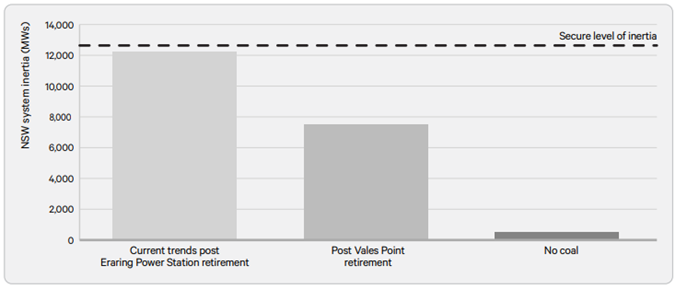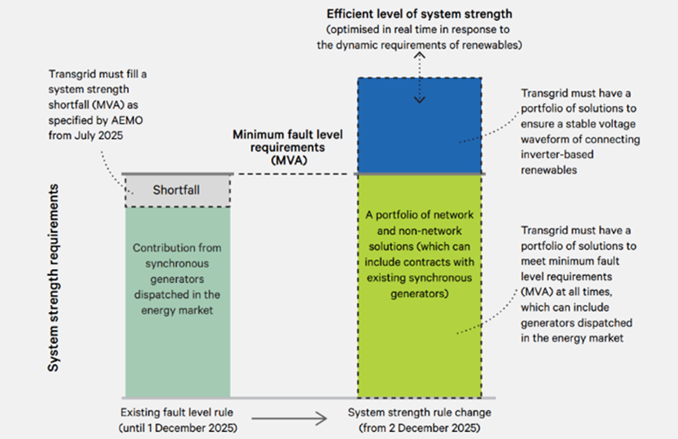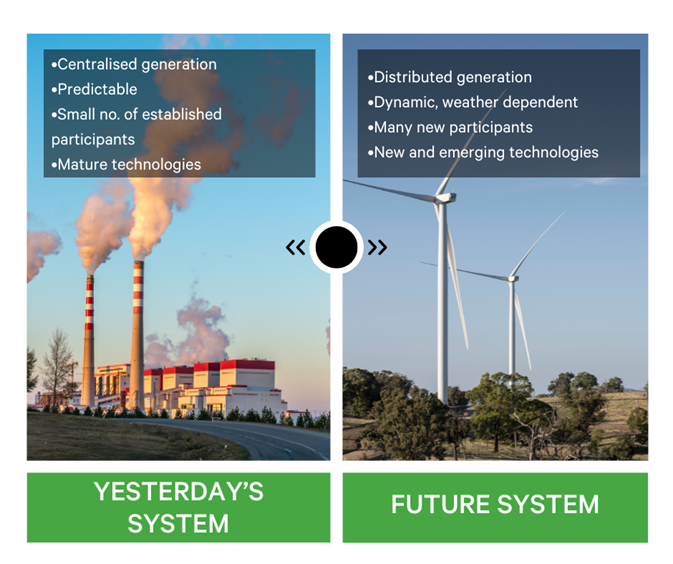The NSW/ACT power system is undergoing a high velocity clean energy transition. As more renewables are connecting to the system and more coal units set to retire in the coming years, we are facing unprecedented challenges to maintain the security and reliability of an increasingly complex and volatile power system.
28 February 2024
The NSW/ACT power system is undergoing a high velocity clean energy transition – in the coming years there will be periods where renewable generation could meet 100% of instantaneous demand. As more renewables are connecting to the system and more coal units set to retire in the coming years, we are facing unprecedented challenges to maintain the security and reliability of an increasingly complex and volatile power system.
Transgrid’s System Security Roadmap outlines the transmission-connected infrastructure required and the uplift in tools and resourcing necessary to operate the system at 100% instantaneous renewable energy. Delivering this program of works is essential to maintain the security and reliability of the power system. Given the volatility of the transmission network in a high renewable future, this article zooms in on the following key aspects:
- System Security – How we will deploy system security infrastructure and services to keep the grid operating within a safe technical envelope.
- Operability – How we will develop our people, processes and tools to meet the increased complexity of planning, managing and operating a grid powered by renewables.
1. What is system security?
System security is when frequency and voltage are maintained within acceptable levels - even when something goes wrong. The power system operates within a secure operating envelope when technical parameters of the power system are maintained within defined limits, such as voltage, frequency, current, power quality and fault levels. These technical limits are necessary to keep the power system safe and secure.
Without system security, there would be a risk of blackouts, power disruptions, and other negative impacts on the economy and society as a whole. To be more specific, system security is an umbrella term for a number of challenges:
- System strength is the power system’s ability to maintain and control the voltage waveform at any given location in the power system, both during steady state operation and following a disturbance such as lightning strikes or equipment failures. High system strength improves our grid’s resilience to disturbances. If there’s a fault or unexpected change on the grid, the voltage waveforms won’t change much and will recover quickly, allowing us to operate our power system safely and stably with minimal impact to energy consumers. A power system with inadequate system strength risks instability and supply interruptions:

Figure 1: The difference in voltage waveforms during and after a fault, for systems with high and low system strength (stylised representation)
- Voltage stability: the ability of the power system to maintain or recover voltage magnitudes to acceptable levels following a contingency event, ensuring the system doesn’t enter voltage collapse.
- Inertia: Inertia refers to the power system's ability to maintain a stable frequency despite fluctuations in supply and demand. This resistance to change helps to maintain frequency and voltage within the technical limits of a secure and stable power system. Following a sudden disturbance, the inertia helps slow down the rate of change of frequency (RoCoF), helping to stabilise the power system and reduce the risk of cascading disconnections.

Figure 2: Inertia levels in NSW against minimum requirements as coal generators retire
1.1 What is AEMO’s role in system security?
The Australian Energy Market Operator (AEMO) holds the responsibility for overseeing the operation of the nation’s power system, and they work tirelessly to keep the National Electricity Market (NEM) operating in real-time, monitoring electricity supply and demand to ensure they are balanced.
Their key responsibility in maintaining system security is ensuring that the power system has the necessary levels of system strength and inertia in the operational timeframe, as explained previously, these two concepts are critical to maintaining power system security and stability.
Without AEMO’s intervention, the power system could experience disruptions or even fail, resulting in significant consequences for the economy and society as a whole.
1.2 What is Transgrid’s role in system security?
As the jurisdictional planner, operator and manager of Australia’s largest electricity transmission network, Transgrid must plan for, build, maintain and operate the backbone of the new grid while meeting our obligations to maintain the safety, reliability and security of the transmission system in accordance with the National Electricity Rules (NER). We are working closely with AEMO to meet specified levels of power system security services in NSW, including system strength, inertia and voltage control.
We carefully assess network and non-network options that can contribute to system strength in NSW, and have been testing the market for alternative and more efficient solutions using the Australian Energy Regulator's Regulatory Investment Test for Transmission (RIT-T).
By working together, AEMO and Transgrid can ensure that the power system remains secure, reliable, and resilient. This collaboration is critical for the sustainable economic growth and development of Australia, enabling the creation of new jobs, encouraging investment in renewable energy, and promoting innovation in technology and infrastructure.
2. The system strength solutions we are working on
We already delved into how system strength and inertia can impact the overall security of a system in the first paragraph. Gaps in system strength will be one of the first, and most significant, challenges for us to resolve. Our analysis suggests that the technologies that resolve system strength can also (with relatively minor adjustments) help meet requirements for inertia and voltage control – making system strength a pivotal service on which to focus.
From 2 December 2025, a new system strength framework will begin under the NER, requiring Transgrid to deliver system strength on a forward-looking basis to standards set by AEMO. Under this framework, system strength will be effectively ‘unbundled’ from the operation of the energy market. Transgrid will be required to establish a portfolio of solutions to ensure minimum system strength requirements are met in full at all times of the year. In addition, we are required to deploy system strength solutions above the minimum levels to facilitate the stable connection and operation of renewables as they come online in NSW in the coming years.

Figure 3: Transgrid evolving responsibilities for meeting system strength requirements in NSW
Transgrid launched the Regulatory Investment Test for Transmission (RIT-T) consultation process in December 2022 to engage the market and identify the best combination of network and non-network solutions to meet power system requirements at the lowest costs to consumers. The likely solutions include a combination of the following network and non-network solutions. We believe that a mix of different technology solutions will best meet the needs of the power system at the lowest cost to consumers:
- Existing synchronous generators dispatched in the energy market, such as coal, gas and hydro. Contributions from these sources are expected to decrease over time as thermal units retire.
- Services outside the energy market, such as existing synchronous hydro units that may be able to operate in ‘synchronous condenser’ mode, or generators considering converting coal units into synchronous condensers.
- Synchronous condensers, which are synchronous motors that spin freely (with no fuel combustion or power generation), used for the purpose of providing system security services.
- Emerging technologies, such as batteries, STATCOMs or renewable generation with grid-forming inverters. Grid-forming inverter technology has significant potential to provide system strength support, in addition to other grid supporting services such as synthetic inertia, fast frequency response and voltage support.
3. Challenges in system operability
A grid operating at 100% instantaneous renewable energy is a fundamentally different system to plan for, operate and manage. Driving this increase in complexity over the coming decade in NSW is the:
- Accelerated retirement (and reduced operation/availability) of over 7GW of coal generation capacity, reducing the share of synchronous thermal generation from 68% today, to 17% in 2033.
- Tripling of the proportion of generation expected to be provided from intermittent renewable sources, including the connection of 28GW of new large-scale renewable generation and storage to the transmission system.
- Integration of at least five renewable energy zones under the NSW Electricity Infrastructure Investment Act 2020, including interfaces with multiple renewable energy zone Network Operators.
- Delivery of a significant program of major transmission projects, including the requirement to take prolonged system outages for construction.
- Almost tripling in capacity of rooftop solar, reducing minimum demand levels, significantly increasing reverse power flows from the distribution to transmission network and creating significant volatility in demand profiles particularly during intermittent cloud cover events.
- On-boarding of new technologies with limited historical data and knowledge of operating performance, including grid-forming batteries, dynamic powerflow technology and compressed air systems.

Figure 4. High level summary of key changes in the power system as part of the energy transition
As the share of renewables grows, the power system is becoming more distributed, dynamic and unpredictable, and increasingly complex to operate. It is also sitting closer to the edge of its secure operating envelope, meaning that a grid disturbance is more likely to escalate, and operators have less time to respond and recover the system. This increases the risk of cascading failures and the potential for major outages.
In the same way that AEMO have examined there needs for addressing system operability through their Engineering Roadmap to 100% Renewables, Transgrid is carefully examining the operability uplift that we need to equip us to plan, manage and operate the power system such that we can maintain a safe and reliable backbone for energy users across NSW and ACT.
4. Making the clean energy transition possible
Transgrid is on the frontline of making profound changes to maintain system strength and ensure the safe and secure operation of the power system. To continue to provide safe and reliable power to millions of Australians, we must:
- Accelerate the delivery of key transmission projects to support energy reliability as coal generators retire.
- Deliver new and essential system security capacity to decouple system security services from coal generation and keep the power system within its secure operating envelope without fossil-fuelled generation.
- Invest in uplifting our operational technology tools, staffing levels and training to ensure the continued operability of a more complex and dynamic power system.
As Transgrid’s FY23 Transmission Annual Planning Report and AEMO’s Draft 2024 Integrated System Plan (ISP) show, investment in transmission is urgently needed to increase the flow of renewably generated power into the grid, so that homes and businesses can continue to access reliable and affordable electricity.
